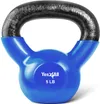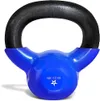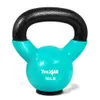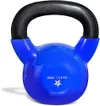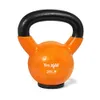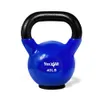
A kettlebell is arguably the most effective strength and conditioning tool in the free weights world. You can experience a full range of motion while using them and experiment with different grips, giving you more freedom with exercises and endlessly diversifying your routine.
Freedom aside, kettlebells also help build full-body strength and boost stability and mobility. And once you’ve learned how to hold a kettlebell properly, they’re actually good fun to exercise with.
One exercise I never get tired of is the most famous kettlebell exercise of all — kettlebell swings. Learning how to do a kettlebell swing will help you build a stronger core and strengthen muscles all over, and depending on the kettlebell swing variation, you can emphasize a range of muscle groups.
That’s why I recommend grabbing one of the best kettlebells for weightlifting and checking out the five best kettlebell swing variations for building strength, muscle endurance, power and core stamina.
What are the five best kettlebell swing variations?
The swing targets your posterior chain — the muscles along the back of your body, including the lower back, glutes and hamstrings. The kettlebell exercise also hits your core muscles, which stabilize your torso, plus the hips, and to a lesser degree (and depending on the variation), your arms and shoulders.
Remember, swings aren’t squats, they’re hip hinge movements. To maintain a snappy hip drive, bring a soft bend to the knees, then lock them in place. Use your hips, glutes and core muscles to drive the weight up, rather than relying on your arms.
Here are five of my top-rated swing variations, the benefits and how to do them.
Get instant access to breaking news, the hottest reviews, great deals and helpful tips.
1. Russian kettlebell swing (RKB)
This OG swing requires you to drive the bell up to eyeline only. It’s likely the first swing you’ll learn, and the best kettlebell swing for beginners.
- Stand with your feet shoulder-width apart and a kettlebell in front of you
- Slightly bend your knees, hinge at your hips and grip the kettlebell with two hands
- Engage your core, then swing the kettlebell back between your legs
- Keep your spine straight and shoulders pulled back
- As you swing upwards, squeeze your glutes and drive the weight to your eyeline. Maintain a soft elbow bend
- Snap your hips forward at the top of the movement without arching your back
- Control the weight back down between your legs.
2. American kettlebell swing (AKB)
American swings are more advanced and require you to swing the bell above your head.
The greater range of motion targets the upper chest and back, shoulders and arms, and takes greater control to stabilize the weight in the overhead position. Build up to this swing and opt for a lighter load until you feel confident.
- Stand with feet shoulder-width apart and a kettlebell in front of you
- Engage your core
- Hinge forward at the hips, grip the weight with both hands and keep a flat back
- Set your shoulders back and down
- Swing the kettlebell between your legs
- Drive the kettlebell upward and snap your hips forward
- Send the weight overhead and squeeze your shoulder blades, back, glutes and core
- Pause, then control the descent back down and between your legs.
3. Kettlebell dead stop swing
The dead stop swing simply involves placing the kettlebell down every rep, requiring you to pick up a dead weight from in front of you, then swing it backward between your legs.
There are benefits to holding your muscles under continued tension with a regular swing, plus it takes a lot of work to control the kettlebell on the way down and allows you to power through reps faster.
However, lifting the weight from the ground can also be beneficial, helping you to focus on your hip drive. The variation also increases hamstring flexibility and builds explosive power, as you can’t rely on momentum to swing the weight.
To do this variation, follow the steps above, but after you swing the weight back between your legs, swing it slightly forward and place it on the ground in front of you. Use this as a reset to move into the next swing.
4. Alternating kettlebell swing
Alternating swings tap into something called unilateral exercise, which is a posh way of saying a single-sided movement. You’ll load one side of the body at a time, teaching the body better balance, coordination and stability.
Plus, holding a weight with one hand is more challenging in terms of load and control than using both, so an alternating swing increases intensity, too. You might decide to drop the load by a few pounds until you feel confident exchanging the weight.
To alternate your swing, exchange hands at the top of the swing. Avoid turning outward as you drive the weight between your legs, as this indicates the weight is controlling you rather than the other way around.
5. Lateral kettlebell swing

Ah, the lateral kettlebell swing. What’s not to love about switching it up entirely and swinging the weight sideways?
This requires you to cross over your body, so I recommend a lighter weight at first. Done correctly, it’s a great way to target those harder-to-reach waist muscles, including the obliques.
- Stand with your feet slightly wider than shoulder-width apart and place the kettlebell between your legs
- Softly bend your knees
- Engage your core and set your shoulders back and down
- Grip the weight with your right hand
- With a straight arm, slightly swing it to the left, then drive the kettlebell across to the right up to shoulder height
- Stand tall and squeeze your glutes, straightening your legs
- Control the weight down and across your body to just below and outside of the left knee. Think about drawing a diagonal line from the kettlebell to the shoulder
- Switch sides.
The bell crosses the body and rotates the midsection, helping to switch on your oblique muscles — the muscles that run down your waist and help the torso flex and rotate.
What are the benefits of a kettlebell swing?
A 2012 study found that people doing kettlebell swings had a similar average heart rate to those running on a treadmill, so expect to test your cardiovascular fitness, as well as your strength.
If you work from home and find yourself stationary, kettlebells help strengthen your hips and lower back, which are muscles crucial for injury prevention and proper posture.
You can include kettlebell swings in pretty much any strength and conditioning workout, and these variations should keep you motivated while teaching you and your muscles a new skill. Challenging your muscles and keeping them stimulated are key to progressive overload, which is the driver for building muscle.
Can kettlebells build muscle?
I wouldn’t program kettlebells as a muscle-building exercise — I would focus on learning the “big 5” compound lifts first, which include the bench press, pull-up, overhead press, deadlift and squat.
However, as a power-building and endurance-enhancing tool? Swings excel. Explosive exercises like swings and plyometrics recruit your fast-twitch muscle fibers and the rapid firing of your muscles.
These muscle fiber types enable you to sustain hard and fast efforts, which improves overall athleticism and your ability to withstand impact.
The design of the kettlebell — the handle welded above the bell — also totally frees up your range of motion, which can aid efforts to increase grip strength, mobility and flexibility.
Research from the Journal of Human Kinetics tells us that kettlebells can improve neuromuscular power, full-body strength, core stability, balance and coordination. Not bad for a small ball of iron!
More from Tom's Guide
- Ditch the bench press — use this 8-minute push-up workout to strengthen your chest at home or the gym
- 5 minutes, 4 exercises and 1 kettlebell are all you need to build total-body strength
- I'm a personal trainer — here's why the 30/30/30 rule is trending

Sam Hopes is a level 3 qualified trainer, a level 2 Reiki practitioner and fitness editor at Tom's Guide. She is also currently undertaking her Yoga For Athletes training course.
Sam has written for various fitness brands and websites over the years and has experience across brands at Future, such as Live Science, Fit&Well, Coach, and T3.
Having coached at fitness studios like F45 and Virgin Active and personal trained, Sam now primarily teaches outdoor bootcamps, bodyweight, calisthenics and kettlebells.
She also coaches mobility and flexibility classes several times a week and believes that true strength comes from a holistic approach to training your body.
Sam has completed two mixed doubles Hyrox competitions in London and the Netherlands and finished her first doubles attempt in 1:11.
You must confirm your public display name before commenting
Please logout and then login again, you will then be prompted to enter your display name.


